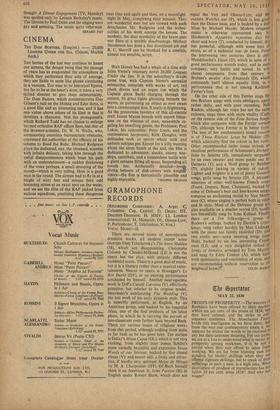CINEMA
The DAM BUSTERS. (Empire.) — 20,000 LEAGUES UNDER THE SEA. (Odeon, Marble Arch.) THE heroes of the last war continue to haunt our screens, the danger being that the passage of years has so evaporated the atmosphere in which they performed their acts of courage, they are liable to seem like ghosts circulating in a vacuum. Too near to be historical figures, too far to be at the heart's door, it takes a very skilled director to give them substantiality. The Dam Busters, which commemorates Guy Gibson's raid on the Mohne and Eder dams, is a good film and an interesting one, and it has one virtue above others of its kind in that it develops a character. Not the protagonist's, which Richard Todd has no chance to enlarge beyond orthodox RAF officer lines, but that of the inventor-scientist. Dr. W. N. Wallis, who, surmounting countless bureaucratic obstacles, convinced the authorities of the efficacy of his scheme to flood the Ruhr. Michael Redgravc plays the dedicated, nay, the obsessed, scientist with infinite delicacy, taking him through the awful disappointments which beset his path with an understatement—a sudden thickening of the voice perhaps, a small drooping of the mouth—which is very telling. Here is a good man in the round. The airmen had to fly in at a height of sixty feet and release their odd bouncing mines at an exact spot on the water, and we see the elite of the RAF picked from various squadrons, practising these dangerous
runs time and again and then, on a moonlight night in May, completing their mission. They are wonderful men but are viewed with such detachment Mr. Redgrave and the techni- calities of his work emerge the heroes. The modesty, the dear normality of the brave puts war films at a terrible disadvantage. Michael Henderson has done a fine directional job and R. C. Sherriff can be thanked for a sensible, almost too sensible, script. • Walt Disney has had a whale of a time with Jules Verne's visionary novel 20,000 Leagues Under the Sea. It is the schoolboy's dream come true, with Captain Nemo's surrealist submarine, complete with works of art, red plush divans and an organ (on which the Captain plays Bach) charging through the oceans, its great lights gleaming beneath the waves, as pulverising an object as ever swam into a cinemascopic lens. It really is frightening. As the precocious inventor of this all-electric craft James Mason broods with superb bitter- ness on the vileness of man, meanwhile re- galing his unwilling guests, the Professor, Paul Lukas, his apprentice, Peter Lorre, and the rumbustious harpooner, Kirk Douglas, with delicacies such as sperm whale milk and unborn octopus pie. Except for a jolly warning about the atom bomb at the end, the film is dedicated to adventure; sharks, enemy war- ships, cannibals, and a tremendous battle with a giant octopus filling all space. Suspending all breath too. Archaically detailed—lov4 diving helmets of dish-covers with knighit' vizors—the film is fantastically plausible and










































 Previous page
Previous page